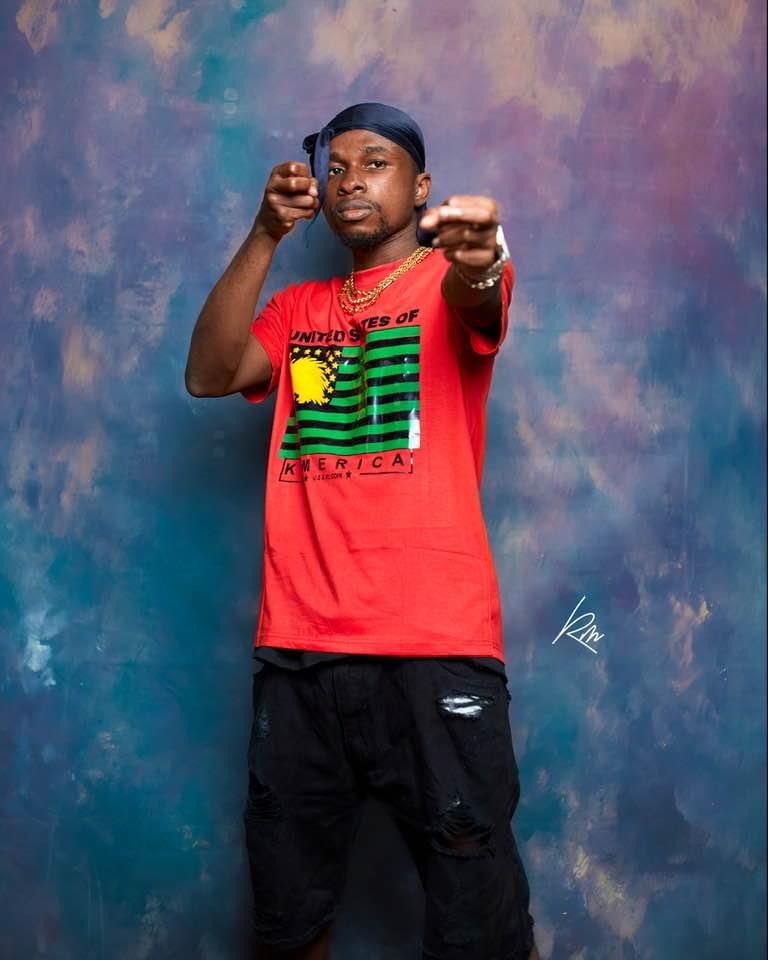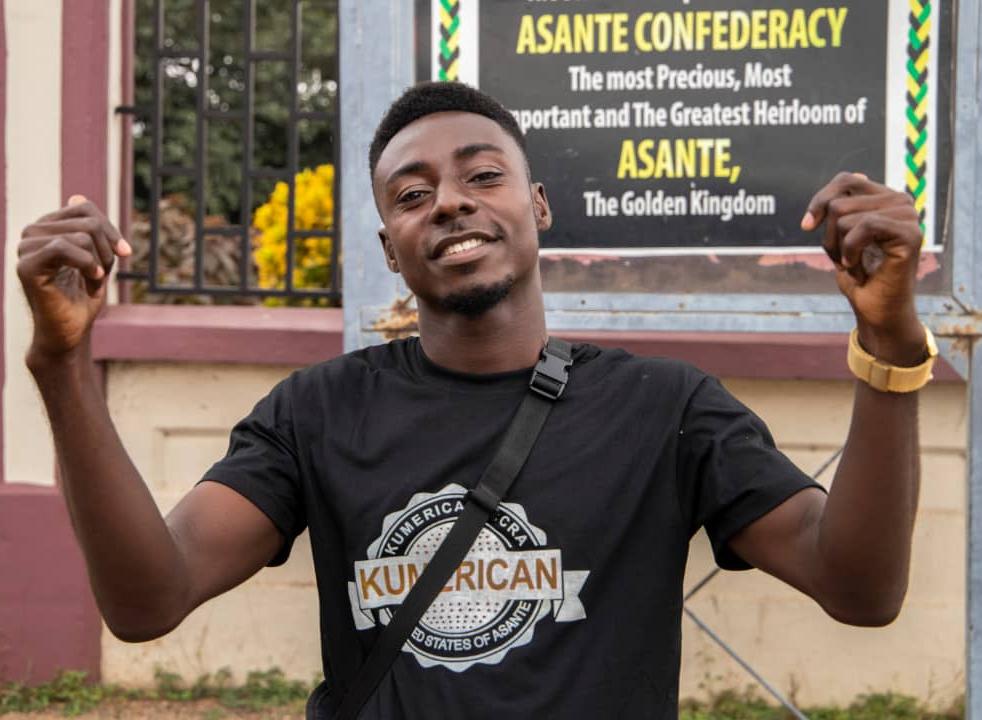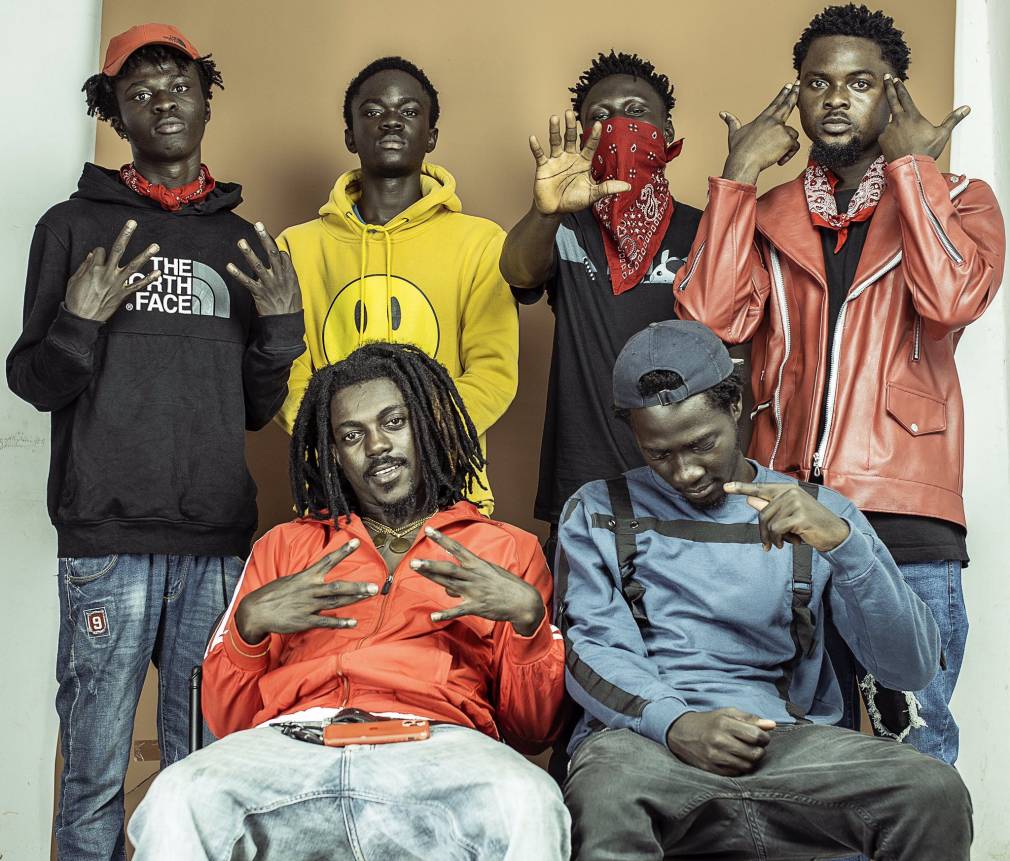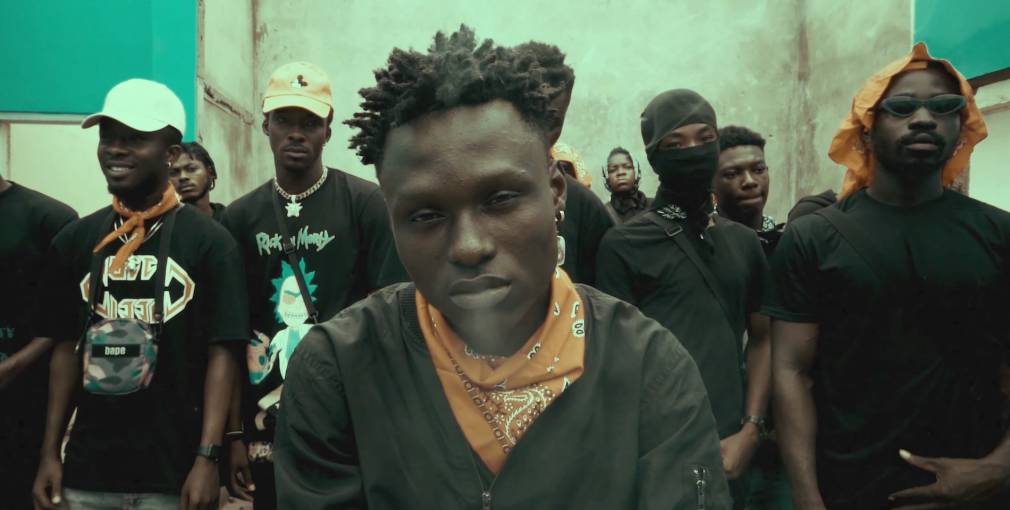The video for “Condemn” is as sinister as its message. Leaning against old cars or on the pavement with their squad, the young rappers display baseball bats, liquor bottles and bandanas eerily reminiscent of the American gang world. The atmosphere is just as heavy in terms of music. A lack of melody in the instrumental is mixed with a heavy bass and aggressive hi-hats. The chorus lyrics – “when we pull on them” – are mixed with gimmicks seriously reminiscent of Kalashnikov shots. Yet, the scene takes place neither in the cold ghettos of Chicago nor on the violent outskirts of Los Angeles. Instead, the video is shot in the middle of Kumasi, second largest city in Ghana, capital of the Ashanti kingdom. The track is none other than the latest release from rapper Jay Bahd and his mates from the Life Living Records label.
Chicago-London-Kumasi, international street music
If Ghana has been known for decades for its warm melodies and playful rhythms, one confinement period was enough for many things to change. In September 2020, a bunch of rappers suddenly gained huge attention on Twitter and Instagram with tracks like “Sore” and “Akatafoc.” No sweet lyrics, no choreography, no Afrobeats: this was drill music. Born in the 2010’s on the South Side of Chicago, a powerful successor to trap music, this rap subgenre tended to present a purer and rawer face than that of mainstream hip-hop. Among the rappers who popularized it (mainly Chief Keef), many had a double life between their gangs and their music, in which they described their macabre acts with precision: drug dealing, assault, murder… This harsh style quickly gained popularity in the impoverished neighbourhoods of Great Britain, before being reappropriated by the United States around 2018, notably through the (deceased) Pop Smoke. “Welcome To The Party”, “Dior”, and the New York rapper with the darkest voice of the game popularised the genre worldwide.
In Ghana, the phenomenon made its way through Kwaku DMC, Jay Bahd, O’Kenneth, Reggie, Yaw Tog, City Boy and many others. Strangely enough, all these drillers claim to be under the same umbrella: Kumerica, a word born from the fusion between Kumasi and America, whose lifestyle is admired by the local artists. A big part of Kumasi’s youth feels represented by the term, and as far as in Accra, the Kumericans are gaining attention. What’s happening in the Ashanti capital?
In reality, the drill is only the tip of the Kumerica iceberg. On the phone with Rabby Jones, co-founder of Life Living Records (one of the most influential labels in the Kumasi drill scene), two comments stand out: “Kumerica is a lifestyle,” and “it’s not a hype.” The term actually encompasses the many codes of the Kumasi streets lifestyle. “The word arrived 4 years ago, with the rapper Blaq Foreigner,” Rabby tells me. “He came up with the term because we live in Kumasi, but we live like Americans. In the ghettos, in Accra it’s dancehall, but in Kumasi it’s rap.” For several decades now, the inhabitants have been inspired by black American cultures, which they have integrated into their own ways of being. Like any subculture, the Kumerica lifestyle is extremely codified. For example, the Kumericans call each other “Akata.” “Last week, an old man was explaining me that Akata is a Yoruba word for a person with a true ghetto experience. It means the same thing here,” Rabby explains. Ironically, for some Nigerians, the word “Akata” refers to African-Americans, a nuance that must surely delight the Akata boys of Kumasi.
Kumasi, capital of hip-hop
A second important element is their language. “We have a code for our Twi: basically we turn the words around,” the manager tells me. “For example, broda (brother). If I were to say broda to a Kumerican, I would say dabro. It’s to speak in code, to keep the discussion between us.” This slang is called Saka, which is the opposite of the Twi word “Kasa,” meaning “to speak.” Saka is not to be confused with Asakaa, which is none other than the famous Drill of Kumerica. Is there anything else we need to know to understand the phenomenon? “Street names, or town names. Bantama is called Florida, Abuakwa has always been called Chicago, and Suame is Miami. But all this is stuff from our ghettos, it was there long before the word Kumerica.” Indeed, if the movement is booming, it is important to understand that it is not just hype. The drill wave is only one element of this broad culture, in which a large Ashanti population recognizes itself. This cold and violent form of rap joins the lifestyle: it is its soundtrack more than its trigger. “Drill instrumentals are very upbeat, and we just think it goes well with the tempo of the Twi.” Rabby adds. Yet, Kumasi’s drill is also part of a long history of Ashanti rap.
Kumasi hip-hop is enjoying new and unprecedented exposure, but the scene has actually been vibrating for years, patiently waiting for an opportunity to break through to the rest of the country. For Ghanaian music journalist Philip Edusei, drill is not a totally new phenomenon: it is actually a very logical continuation of the various rap waves that Ghana – and the world – have experienced. Between the 1990s and 2000s, for example, the trend was hiplife, a hybrid genre-blending hip-hop with highlife. The movement’s biggest artists became idols to the Ghanaian youth, touring and appearing all over the country. “Well, most of these artists came from Kumasi or had some kind of association with the city,” Philip tells me. “The duo Akyeame, for example, or Lord Kenya, were from Kumasi. Even Reggie Rockstone, known as the Godfather of Hiplife, is the self-proclaimed President of Oseikrom, another nickname for the city.”
Between 2000 and 2010, the kingdom’s rappers followed the same rap trends as the world, converting to gangsta rap or trap music, for example. However, there was no comparable impact to the Kumerica phenomenon. “The problem is that although Kumasi is home to a lot of talent, it has never been recognised musically because Accra is the capital,” Philip explains. “If you start to be popular, after a while you have to relocate to Accra.” “Before the drill, there was no base in Kumasi,” Rabby Jones adds. “The music was watered down, even though there were a lot of artists.” Yet, one mystery remains: what is the explanation behind the alchemy between the city and rap? What makes Kumasi so in love with hip-hop? According to online sources, this relationship dates back to the 1980s, when Ashanti men migrated to the West and came back to Kumasi with new influences, notably African-American ones. Philip intervenes: “I think this hypothesis is more about Boga highlife. A Boga is a Ghanaian who went to live abroad for a long time and came back. In the 80s, many artists came back from the US or Europe and started to integrate Western elements into their highlife. But it’s interesting to see that Reggie Rockstone, for example, is a Boga himself: he lived in London and New York before returning to Ghana.” Could the Asakaa drill be the illegitimate daughter of Boga highlife… ? My other interviewees all offer a different explanation: gold. This precious metal indeed occupies a central place in the American rapper aesthetics, filled with ostentatious jewellery which act as tokens for their success. This aesthetic probably found particular resonance in Kumasi, the home of Ashanti culture, where gold occupies an equally important place. “Our kings wear 24-carat gold chains,” Rabby simply tells me, without even needing to mention their gold rings, gold bracelets and gold thrones. The young people of Kumasi have long since made the connection between their American rap idols’ jewellery and their kings. The city was indeed a fertile ground for the birth of a hip-hop movement.

Sounds and tales from the ghetto
Kumasi embraced hip-hop, and drill embraced Kumasi. The sub-genre, cold and aggressive, found the right fit in a country paradoxically known for its warmth, welcoming culture and safety. This reputation however overshadows the 25% of the population living below the poverty line, in frustration and anger. For Lil Fyve, a proudly Kumerican rapper, drill is the best way to describe the harsh reality of the streets, whether in America, in London or in Ghana. “I started doing drill in 2014, just like in Chicago,” he tells me live from Kumasi. “When the hip-hop trend switched to trap, it was more about the melodies, the mumbling… You couldn’t say what was in your heart.” Indeed, although it deals with the same realities, drill could be described as more simplified musically than trap. This adds an extra sound space, which allows the artists to be more straightforward in their words. “I rap about my life, and I’ve been through a lot,” the rapper continues. “I rap about my suffering, my betrayals, about what happens in the streets. Drill allows you to do that, it gives you time to talk about your feelings, even if you’re a hardcore rapper. And I also try to motivate the people of the streets to never give up.” In addition to being a vehicle for expression, drill has also served as a getaway for many Kumericans whose trajectories could have gone really wrong. “Personally, before the music, I was deeply into scamming,” Rabby Jones admits on the phone. “All the artists with me are boys picked up from the streets. Some of them were into burglary.” Violent, dark, aggressive, macabre, certainly. But the arrival of drill has been beneficial for many, and the popularity the subgenre is enjoying is understandable. “Chicago has become Chiraq (because of the city’s homicide statistics being as high as in Iraq), and Kumasi has become Kumerica.” Rabby smiles. United by music, the two cities are also united by crime. “There are members of the Bloods (a powerful American gang) from Washington DC here,” the manager adds. Connected to the Bloods of the United States? “Yes, somehow.”

Elegant Kumasi
But what would Kumerica be without its fans and supporters? Carried by thousands of young people from Kumasi (and elsewhere), it is also thanks to them that the term has flooded the web and the public sphere. Rich or poor, living in Kumasi or not, these young fans have taken Kumerica from a subculture to a much broader label. Nowadays, to be a 2.0 Kumerican, new criteria have replaced the simple condition of belonging to the city’s ghettos. Firstly, on social media, one’s location should be replaced with “Kumerica.” Secondly, if possible, it is required that you speak Saka. Thirdly, a must, you have to wear Kumerica merchandise: jumpers, caps, T-shirts… I got in touch with Kwame Kantinka, who is not a rapper, but who explains to me that he is “the representative of the Kumericans in Accra.” He tells me enthusiastically that through social media, the movement’s supporters have organised themselves into branches. The actions of each group are extremely diverse. “These days, we are selling a lot of t-shirts,” he tells me, very excitedly. “And it’s a collective art: we design and print everything in Kumasi. When you wear the t-shirt, people call you out in the street, Kumasi people will recognise you… You look in the mirror and you tell yourself that you are an Ashanti man, anything is possible!” The young people of the kingdom seem to be delighted with this new label, stylish and trendy. For once, Kumasi is no longer number 2, and its inhabitants no longer live in the shadow of a capital city where the industry is already well established. But beware: “let me be very clear,” Kwame warns me, “Kumerica does not belong to the Ashanti people. It belongs to every Ghanaian who loves the culture of Kumasi.” No ethnicism here, then. On the contrary, young Kumericans do everything to distinguish themselves from an image that could be seen as ethnically divisive or gang affiliated. Kwame tells me that last month, the Accra Kumerican branch carried out a campaign to clean up certain districts of the capital.
But generating so much excitement is bound to attract critics. And it is always hard to keep everything authentic while the trend is ongoing. “Some people will tell us they are Kumericans because they were born in Kumasi, they went to church in Kumasi, they did this in Kumasi…,” Lil Fyve tells me. “Ok, we accept. But it’s just for the trend. Many of them have no street credibility, the street doesn’t know them. They moved to Accra, where they have advantages over us. At the end of the day, we will see who is really street and who is not.” And beyond notions of hype and reclaimed identity, the movement already recieves its fair share of criticism. With the gangster attitude the rappers exude and the resulting social frenzy, Kumerica is seen as a scary phenomenon. When extreme fans started to print out Kumerican “United States of Ashanti” passports, accusations of sectarianism and separatism spread all over the country. “But no Ashanti ever spoke about having our own independence. The passports were just a joke!” Kwame Kantinka firmly states. The Kumericans are also under attack about their music, accused of entirely copying UK and American rappers. “But Asakaa is different, you add flavour to it”, Lil Fyve replies. “We’re helping to promote hip-hop worldwide, because hip-hop is for everyone.” “And everything we say in our music really happens,” Rabby adds. Even if the Kumasi ghetto reality is not likely to stop any time soon, some may wonder whether the new attention around Kumerica will prove to be more than temporary. The subculture has existed for years and will definitely survive. But how can the media and social craze be sustained? Lil Fyve is more pragmatic, saying that the change will come through concrete projects: “with my team, we plan to organize an annual street festival to promote the culture. With time, the trend may stop on social media, but every year we will talk about Kumerica. We have measures in place.” For Rabby, it’s more a question of mentality. “We’ve been underground for more than 10 years,” he concludes serenely. “We are ready.”





